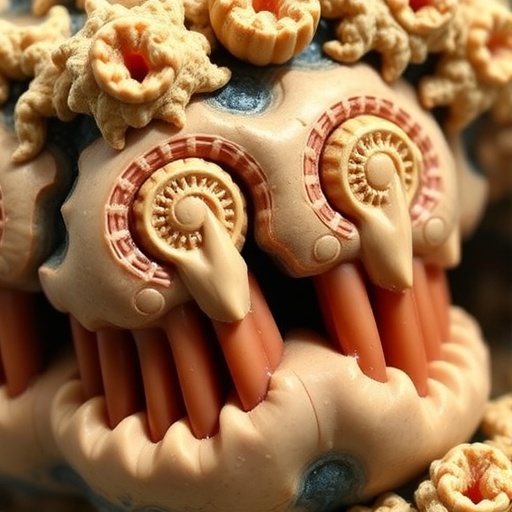In the intricate world of biomineralization, nature continues to astonish scientists with its sophisticated mechanisms for constructing durable, functional materials. A recent breakthrough by researchers at Okayama University in Japan illuminates how chitons—marine mollusks renowned for their sturdy feeding apparatus—deploy a unique protein to precisely regulate the deposition of magnetite, an iron-based biomineral, onto their radular teeth. This discovery offers not only profound insights into biological mineralization but also tantalizing prospects for environmentally benign synthesis of magnetic materials with diverse technological applications.
Biomineralization—the controlled formation and deposition of minerals within living organisms—underpins the development of a vast array of hardened biological structures, including shells, skeletons, and teeth. While calcium-based minerals and silica dominate biomineral matrices in many species, magnetite (Fe₃O₄), notable for its robust magnetic properties, is comparatively rare in nature. Its biological formation requires exquisite regulatory frameworks to manage iron accumulation and mineral phase transformations, as iron toxicity poses significant risks to cellular health. Chitons have evolved a remarkable solution to this challenge, engineering magnetite-coated radular teeth that can endure the abrasive demands of scraping algae off rocky substrates.
The radula of chitons functions as a continuously renewed conveyor belt of teeth, enabling relentless feeding efficiency. Within this specialized organ, multiple sequential stages of tooth maturation occur. Initial stages involve the organic chitinous scaffold, which subsequently undergoes mineral infill and conversion steps that culminate in fully magnetite-hardened cusps. Despite its functional importance, the molecular orchestration driving iron ion deposition, ferrihydrite precursor formation, and magnetite crystallization within the radula’s mineralizing zone remained an elusive enigma—until the advent of this novel investigative work.
The interdisciplinary team from Okayama University, led by Associate Professor Michiko Nemoto, employed rigorous proteomic analyses contrasting protein expression profiles between radular bases and mineralized cusps of the gumboot chiton, Cryptochiton stelleri. This approach isolated 22 proteins uniquely abundant in the mineralized domain. Among these, the radular teeth matrix protein 1 (RTMP1), identified as a chiton-specific factor, emerged as a critical agent guiding mineral deposition. Further investigations confirmed the presence of RTMP1 homologs across other chiton species such as Acanthopleura japonica, Acanthochitona achates, and Placiphorella stimpsoni.
Magnetite is extensively utilized in technology—ranging from data storage media to magnetic resonance imaging (MRI) contrast agents—owing to its stable magnetic properties. However, conventional synthetic methods for magnetite usually necessitate harsh environmental conditions, including elevated temperatures and toxic reagents, posing ecological downsides. RTMP1’s inherent biological capacity to catalyze magnetite formation at ambient conditions holds transformative potential, suggesting pathways towards green synthesis protocols that mimic nature’s finesse.
The researchers meticulously monitored RTMP1 expression dynamics throughout discrete stages of chiton tooth development. Stage 1 involved transparent teeth predominantly composed of the chitinous matrix, devoid of substantial mineralization. Stage 2 marked the onset of ferrihydrite (an iron oxyhydroxide) infiltration, evidenced by reddish-brown pigmentation, while Stage 3 reflected the critical transition to darkly pigmented teeth as ferrihydrite underwent phase transformation to magnetite. RTMP1 homolog expression peaked in cells isolated from Stage 2, implicating the protein in orchestrating iron oxide nucleation and early mineral stabilization.
High-resolution localization studies revealed that RTMP1 homologs were strategically expressed in epithelial cells flanking both the leading and trailing edges of immature radular teeth prior to iron deposition. Remarkably, these proteins pre-localized within the internal tooth regions designated for mineral accretion. Subsequent delivery of iron ions, mediated by ferritin carriers, converged on these RTMP1-rich zones, catalyzing site-specific iron oxide nucleation. As mineralization proceeded and teeth matured, RTMP1 localization shifted and became concentrated near the trailing edge epithelial cells, highlighting species-specific spatial-temporal regulation of mineral patterning.
Functional assays underscored the catalytic role of RTMP1 homologs in promoting iron oxide nucleation on chitin substrates. By binding to chitin fibers, RTMP1 guided the spatial organization and crystallization of iron oxides, enhancing the durability and magnetic coherence of the resulting mineralized teeth. Interference RNA (RNAi) experiments targeting RTMP1 transcripts in Acanthopleura japonica led to a significant reduction—approximately 69%—in RTMP1 expression. Correspondingly, affected chitons exhibited diminished tooth mineralization progression, as indicated by lighter coloration and incomplete maturation, affirming RTMP1’s central role in radular biomineral assembly.
These revelations clarify how chitons manage the delicate balance between harnessing iron’s indispensability and mitigating its cellular toxicity. By precisely localizing RTMP1 and regulating iron deposition kinetics, chitons produce ultrahard, magnetite-rich teeth optimized for their rugged marine habitats. Beyond biological curiosity, understanding such protein-directed mineralization can inform the development of synthetic strategies mimicking biomineral formation—potentially enabling fabrication of finely patterned metal oxides under mild conditions for electronic and biomedical applications.
Dr. Nemoto emphasizes that RTMP1 may inspire innovative biofabrication techniques requiring controlled patterning of metal oxides at predetermined sites. Such precision assembly could revolutionize sensor technology, data storage devices, and novel magnetic materials. Moreover, this protein’s regulatory influence on iron metabolism could open new investigative avenues in iron homeostasis research and pathologies connected to iron dysregulation, including neurodegeneration and oncogenesis.
The discovery of RTMP1 as the first eukaryotic protein identified to facilitate magnetite biomineralization embodies a landmark advancement, bridging molecular biology, materials science, and ecology. It enhances our comprehension of evolutionary adaptations enabling organisms to exploit transition metals biochemically while minimizing deleterious effects. The chiton radula thus serves not only as a subject of marine biology but also as a blueprint for biomimetic material innovations inspired by nature’s millennia-honed craftsmanship.
Overall, this study exemplifies the power of integrating proteomics, molecular biology, and imaging to unravel biochemical processes in vivo that synthesize complex functional materials. The insights afforded by RTMP1 augment the expanding landscape of biomineralization research and signify an exciting frontier where bioinspired materials design converges with sustainable technology development. As applications mature, RTMP1-based methods could redefine how magnetite and related metal oxides are produced in labs and industries worldwide.
Subject of Research: Animals
Article Title: Radular teeth matrix protein 1 directs iron oxide deposition in chiton teeth
News Publication Date: 7-Aug-2025
Web References: https://www.science.org/doi/10.1126/science.adu0043
Image Credits: Associate Professor Michiko Nemoto, Okayama University, Japan
Keywords: Life sciences, Iron, Minerals, Biomineralization, Magnetite, Marine resources, Oxides, Metal oxides, Proteins, Magnetic properties




